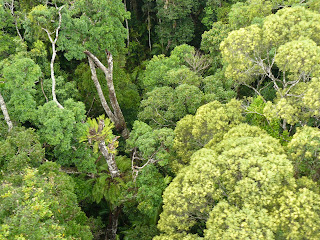
This is a Golden Bog Spider and it's difficult to tell it's size in this photo. It's about 5 inches in length! Unlike it's cousin the Garden Bog Spider it isn't poisonous.
Australia’s World Heritage listed Tropical Rainforests are one of the oldest continually surviving tropical rainforests on earth.
Fossil pollen records indicate that closed forests used to cover the entire Australian continent some 50 to 100 million years ago, when it was still a part of the super-continent land mass known as Gondwana.

Today, due to climate changes and human impact, they occupy a small coastal strip along Queensland’s north-eastern coastline between Cooktown and Townsville, accounting for approximately 900,000 hectares, representing about 0.1% of Australia’s total land mass. They are home to a diverse array of rare and threatened plant and animal life.

Ever wonder what makes a tropical rainforest?
1.Rain
Tropical rainforests exist where 1300 mm of rain falls each year. Australia’s tropical rainforests get 4000 mm of rain each year mainly between the months of December and March.
2. Sunlight
You need a warm and humid climate most sunlight is filtered by the rainforest trees.
3. Closed Canopy
The leaves of the tall trees block the sunlight from the forest floor creating what is known as a closed canopy.

Tropical rainforests are home to an amazing variety of plant and animal life; they are a perfect example of biodiversity.
Biodiversity refers to the astonishing number of and variety of living things found on earth and the connections that exist between them. Globally, Australia represents the seventh richest country in terms of biodiversity supporting 7% of the world’s species.
The world’s rainforests are home to more than half of all known animal species, many of which are found nowhere else.
Flying Fox

Rainforest trees provide a safe habitat for birds and other animals, as well as being a protective and fertile environment supporting the existence of other rainforest plants, like vines, ferns and orchids.
Rainforests play a vital role in the ongoing existence of human beings; they help to clean the air we breathe by absorbing carbon dioxide and producing oxygen, which we inhale, they also regulate the water cycle and can modify local climate. The forests are also an important source of food and medicine.

Today we train to Kuranda. We’ve been told this rainy season is the best time to visit the rainforest because with all this rain there are waterfalls everywhere! On the train ride we stopped at Barron Falls.

Once at the top at Kuranda we had lunch and went on a jungle walk through the forest. It was nothing short of amazing to see and hear all the wildlife!
Barron Falls

We took the skyrail down: the longest gondola in the world – 7.5 km! It was completed in 1995 and coast over 35 million and an additional 2.5 million in financing. There was a stipulation that in building the skyrail they were not allowed to walk on the forest floor. So Russian helicopters were used to construct the gondola by air! The highest tower is 40 meters above the rainforest floor. Can you imagine traveling up and over the canopy?

We traversed Barron Gorge National Park. The park was established in 1940 and is comprised of 2820 hectares.
This is definitely one of our most exciting experiences so far!




1 comment:
That is one creepy looking spider. It sounds like you are having a great time there and lots to see in Australia. The pictures are awesome to see. Hope all is well and you are taking care. We are finally having some nice weather here but not as nice as what you are having. Take care.
Val Kiraly
Post a Comment